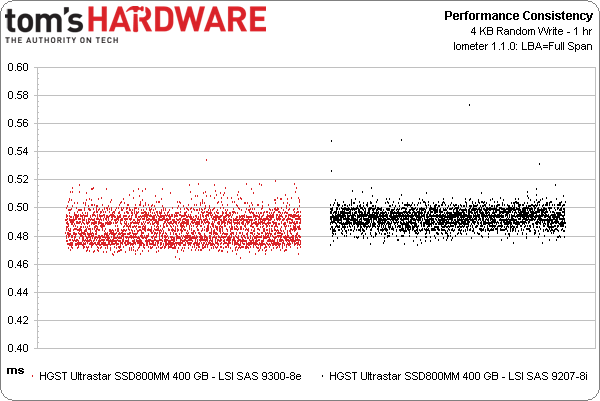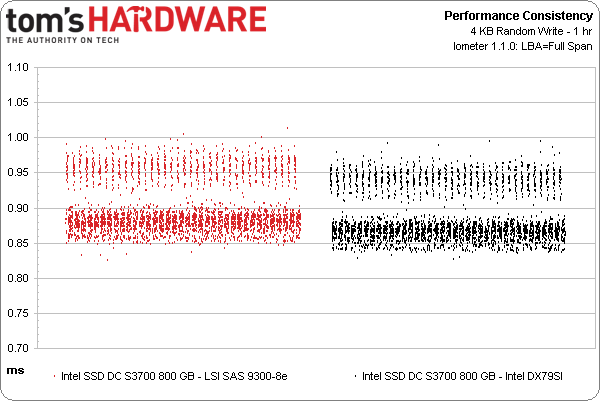LSI SAS 9300-8e & HGST Ultrastar SSD800MM: 12 Gb/s SAS, Tested
With the announcement of LSI's SAS 9300-8e and HGST's Ultrastar SSD800MM earlier this year, the world was officially introduced to 12 Gb/s SAS. Today we get our first look at how two times the interface bandwidth translates to real-world performance.
Results: Performance Consistency
Increasingly, we pay close attention to the performance consistency of enterprise-class SSDs. This is what separates a good drive from a great one when all of the corner case testing seems equal. Over the past year, we measured this in terms of large-block transfers in our Enterprise Video Streaming section. Armed with that data and our exclusive analysis, the peaks, valleys, and frequency of each became clear. If you look at the information for long enough, you start to see fingerprints for each drive.
We started with large-block transfers because, in enterprise video applications, if you don't buffer or write data fast enough, you can lose it completely. Random 4 KB transfers are slightly more academic, but they also emulate database transfers pretty well. With this sort of workload, you might not actually lose anything, but your system will certainly slow down.
In the following tests, we subjected HGST's SSD800MM to 25 hours of continuous random 4 KB writes across the entire drive. We recorded the IOPS every second, giving us 90,000 data points. We then zoomed in to the last 60 minutes to more coherently visualize the results.
Not only did we want to look at the write latency on LSI's SAS 9300-8e, but we also want to compare that information to the 6 Gb/s-capable LSI SAS 9207-8i. If you recall from our random write testing, both HBAs easily keep up with the SSD800MM's 66,000 write IOPS.
HGST's drive performs well in both cases. Connected to the SAS 9300-8e, the SSD800MM doesn't post a single data point above 0.55 ms. In fact, 99.97% of the data points are below 0.52 ms, while 95% are under 0.5 ms. On the SAS 9207-8i, 99.98% of the data points fall below 0.55 ms, while 99.88% are below 0.52 ms and 92.7% come in under 0.5 ms.
The SAS 9207-8i produces a slightly tighter concentration of data, where we observe a standard deviation of 0.0142 ms, along with a variance of 0.000201. The SAS 9300-8e has a standard deviation of 0.0157 ms with a variance of 0.00246. In the end, the SAS 9300-8e manages a lower overall average, even though its data isn't as tightly packed.
There's a fairly even distribution of latency from the SAS 9300-8i, between 0.47 and 0.5 ms, with no obvious pattern. This is a really good result that shows that internal operations, such as garbage collection, are not getting in the way of write performance. It probably has a lot to do with the massive amount of over-provisioning (44%) that the SSD800MM enjoys.
Get Tom's Hardware's best news and in-depth reviews, straight to your inbox.
Comparing LSI's SAS 9300-8e to Intel's X79 Express using the SSD DC S3700 yields a similar theme as our previous tests. Namely, the integrated SATA controller offers slightly lower latency, though the difference is only a few microseconds.
Current page: Results: Performance Consistency
Prev Page Results: 4 KB Random Performance And Latency Next Page Results: Enterprise Workload Performance-
major-error The performance and relative maturity of this prototype drive certainly is impressive, but this is what the enterprise space demands.Reply
At the consumer level though, the article takes on a completely different tone--I would be very surprised if we don't start seeing mention of PCIe4 at/before the top of the next CPU cycle (so, in 24-36 months at most.) -
raidtarded Actually, Adaptec already saturated PCIe 3.0 with 6GB/s. The chart is incorrect, it doesn't take 12Gb/s to saturate the PCIe bus. Well, not for Adaptec.Reply -
falcompsx Remember when mechanical hard drives struggled to saturate their interfaces? Times sure have changed with SSD tech.Reply -
CaedenV Reply11006286 said:The performance and relative maturity of this prototype drive certainly is impressive, but this is what the enterprise space demands.
At the consumer level though, the article takes on a completely different tone--I would be very surprised if we don't start seeing mention of PCIe4 at/before the top of the next CPU cycle (so, in 24-36 months at most.)
Ya, my bet is that we will not start to see SATA4 or PCIe4 until Skymont at the earliest. Considering it is looking like Broadwell may be pushed back due to 14nm die shrink issues I would bet that Skymont will have similar issues when moving to 10nm. But at least for home users you can cram 2 SSDs in RAID0 with a proper RAID card and get a little performance boost until then. I guess the only problem is that most people are going to use the onboard Intel RAID for RAID0, which will get you a killer synthetic benchmark, but in practical reality it is really just expanding your volume with very little speed benefit. -
bit_user * wipes drool off floor *Reply
That's a quality review of some quality products. I like the insights shared, throughout. I especially appreciated the link to the SATA-Express paper. Thanks!
MORE REVIEWS LIKE THIS!!
:) -
bit_user Reply
How many ports and how many lanes, though? If it's just a 8-port card, the math doesn't support that, as 6x8 = 48 Gbps, which is less than the 8 x 8 = 64 Gbps that a x8 PCIe 3.0 slot should carry.11006482 said:Actually, Adaptec already saturated PCIe 3.0 with 6GB/s. The chart is incorrect, it doesn't take 12Gb/s to saturate the PCIe bus. Well, not for Adaptec.
-
raidtarded It is the equivalent of a nuke bomb compared to the LSI products. It has 24 Native ports.Reply11011736 said:
How many ports and how many lanes, though? If it's just a 8-port card, the math doesn't support that, as 6x8 = 48 Gbps, which is less than the 8 x 8 = 64 Gbps that a x8 PCIe 3.0 slot should carry.11006482 said:Actually, Adaptec already saturated PCIe 3.0 with 6GB/s. The chart is incorrect, it doesn't take 12Gb/s to saturate the PCIe bus. Well, not for Adaptec.


